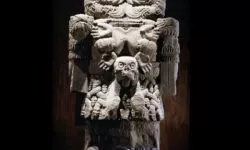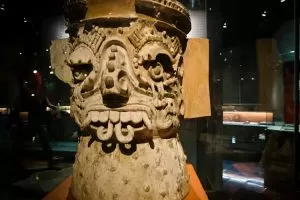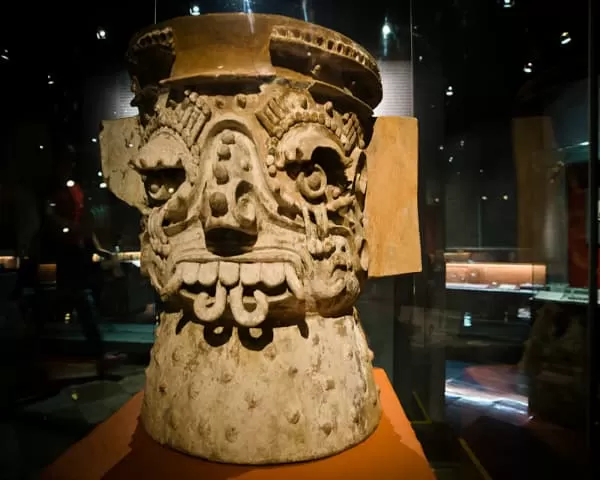Meaning of the God Tlaloc
Tlaloc, “the one who makes things grow”, god of rain and lightning, is the most important deity of this group of gods.
Tlaloc, the god of rain and water, was associated with life and sustenance and fertility, as well as springs, mountains and caves. The name Tláloc derives from the Nahuatl words tlali meaning “earth” and oc meaning “something on the surface”.
However, the origins of the god are probably much earlier, as it shares many similarities with the Olmec God IV and the Maya God B or Chac. In the diverse Mesoamerican cultures, Tláloc appears as Dzahui for the Mixtec, Tajίn for the Totonac, Chupithripeme for the Tarascan and Cocijo for the Zapotec.
Who is the God Tlaloc ?
He was often depicted with bulging eyes, fangs and a curly nose. Child sacrifices were made and the children were expected to cry to bring rain.
Although Tlaloc was generally a beneficent god, he had the power to unleash floods and send droughts, hail, ice and lightning. Therefore, he was also a god to be feared when he was angry; and in order to appease him and seek his favor, children were especially sacrificed, as well as prisoners dressed as the god.
One of the most important and formidable gods of the Aztec pantheon, was considered the god of rain, water, lightning and agriculture. He was seen both as a benevolent god who provided life-giving rain as well as a relentless and destructive deity when he sent storms and droughts.
In the Aztec Creation myth, Tlaloc was ruler of the 3rd Sun, he was linked to Mázatl (Deer) on the 7th day, his calendar equivalent was 9 Ocelotl – the Jaguar, he was the number 8 of the 13 Lords of the Day and the ninth Lord of the Night and his animal sign was the eagle.
Born during the Creation when Quetzalcoatl and Huitzilpochtli (or in some versions Tezcatlipoca) dismembered the reptile monster Cipactli, Tlaloc was associated with any weather condition related to water, such as rain, clouds, storms, floods, lightning, snow, ice and even ashes. .
Tláloc also had four particular manifestations such as the four colors and the four cardinal directions, collectively known as the Tlálocs which included Nappatecuhtli, the creator of trade tools and hunting weapons, and Opochtli, the patron of Chalco.
In a colorful image, Tlaloc was believed to have about four giant flasks, each representing the cardinal directions. From the East jar, Tlaloc distributed the rains so essential for life, while from the other jars the god dispensed the terrible scourges of drought, diseases and frosts so deadly for humanity and crops.
Alternatively, it was thought that rain came when the Tlálocs used sticks to break the jars of water that were inside the mountains. In fact, it was believed that the sound of thunder was the noise that was made when these jars of water were broken.
What Attributes Does God Tlaloc Have ?
He was the main god of the Olmec culture and appears with the mask of the jaguar snake on the colossal axes and clay and jade figurines of this very ancient and advanced culture.
There are many representations of Tlaloc in sculptures, paintings and clay pots. It can be said that wherever there is a small isolated mound in the middle of a valley, archaeological remains will surely be found within it that show that the rain god was worshipped there.
Tlaloc is one of the easiest gods to identify due to its characteristic mask, which, seen from the front, gives it the appearance of wearing glasses and a moustache. In a piece of sculpture now in the Museum of Ethnography in Berlin, it is evident that, in reality, this mask is formed by two snakes intertwined to form a circle around the eyes, with the mouth of the snakes gathered over the mouth of the god.
Tlaloc’s characteristic mask, as well as almost all his garments, is painted blue, the color of water against the sky, thus representing the clouds. Tlaloc’s face and body are generally painted black, as it represented mainly storm clouds; on the other hand, the white clouds are symbolized by the headdress of heron feathers, aztatzontli, which he wears on the crown of his head.
He is usually seen holding a cane of flowers in one hand and sitting on a jade seat; raindrops falling from the sky form the background. At the nape of his neck is the fan of pleated paper mentioned above; on his head is a conspicuous jewel, with two quetzal feathers, called quetzalmia-huayo, “the precious leaf,” meaning corn, which depends so much on the rain god.
The representations of a rain god with a peculiar mask, with large round eyes and long fangs, go back, at least, to the Teotihuacan culture of the highlands. Its characteristic features were similar to those of the Mayan rain god Chac of the same period.
What is the Power of God Tlaloc ?
It could cause floods, droughts or lightning all over the earth. He could send torrential rains, hurricanes and instigate hunger with his powers if he was angry.
History of the God Tlaloc
For an essentially agricultural people, such as the Aztecs, the rainy season and other atmospheric phenomena that influenced their crops were of fundamental importance. Therefore, it is not surprising that the worship of the gods of water and vegetation occupies a large part of their religious life.
It is also very likely to be the oldest of the gods worshipped by man in Mexico and Central America. The Mayas called it Chac, the Totonacas called it Taj, the Mixtecs worshipped it under the name of Cocijo. In all parts of Mexico and Central America, worship of him is so ancient that its beginnings are lost in the distance of antiquity.
During Aztec times (14th to 16th centuries), the cult of Tlaloc was apparently considered extremely important and had spread throughout Mexico. In the divinatory calendars, Tlaloc was the eighth ruler of the days and the ninth lord of the nights. Five months of the 18-month ritual year were dedicated to Tlaloc and his fellow deities, the Tlaloque, who were believed to dwell on mountaintops. The children were sacrificed to Tlaloc in the first month, Atlcaualo, and in the third month, Tozoztontli.
During the sixth month, Etzalqualiztli, the priests of the rain ceremonially bathed in the lake; they imitated the shouts of the aquatic birds and used magical “fog rattles” (ayauhchicauaztli) to obtain the rain. The month 13, Tepeilhuitl, was dedicated to the mountain Tlaloque; Small idols made of amaranth paste were killed and ritually eaten. A similar rite took place in the 16th month, Atemoztli.
Tlaloc had been one of the main deities of the agricultural tribes of central Mexico for many centuries, until the warrior tribes of the north invaded that part of the country, bringing with them the astral cults of the sun (Huitzilopochtli) and the starry sky (Tezcatlipoca). Aztec syncretism placed both Huitzilipochtli and Tlaloc at the head of the pantheon.
The Teocalli (Great Temple) in Tenochtitlan, the Aztec capital, supported two sanctuaries of the same size in its high pyramid: one, dedicated to Huitzilopochtli, was painted in white and red, and the other, dedicated to Tlaloc, was painted in white and red. blue.
The high priest of the rain god, the Quetzalcoatl Tlaloc Tlamacazqui (Feathered Priest, Tlaloc Priest) ruled with a title and rank equal to that of the high priest of the sun god. Tlaloc was not only highly revered, he was also highly feared. He could send rain or cause drought and hunger. He threw lightning onto the earth and unleashed devastating hurricanes.
It was believed that the Tlaloque could send to the earth different types of rain, beneficial or destructive of crops. It is said that certain diseases, such as hydrops, leprosy and rheumatism, were caused by Tlaloc and his fellow deities. Although the dead were generally cremated, those who had died from one of the special diseases or who had drowned or had been struck by lightning were buried. Tlaloc gave them eternal and happy life in their paradise, Tlalocan.
Associated with Tlaloc was his companion Chalchiuhtlicue (“She who wears a jade skirt”), also called Matlalcueye (“She who wears a green skirt”), the goddess of freshwater lakes and streams. Some sources indicate that she was one of the four original creator gods created by the supreme being Ometeotl; Her brothers were the two Tezcatlipocas (Red and Black) and Quetzalcóatl.
Others claim that the four sons of Ometeotl were Tezcatlipoca, Xipe Totec, Huitzilopochtli and Quetzalcóatl, and that Tlaloc was created later.
Myths about the God Tlaloc
To create the god and goddess of water, the four gods met and made Tlaloc and his wife Chalchiuhtlicue, god and goddess of water, and one of them sought water when necessary.
It is said that the dwelling of the water god has four rooms, and that in the middle of a large courtyard there are four large jugs of water. The water in a pitcher is very good, and from this pitcher come the rains when the grain and seeds sprout and the climate is good.
In another pitcher the water is bad, and when the rains come from this pitcher, cobwebs form in the grain and in the molds of the grain. The third jar contains water that sends freezing rains; the fourth jar sends the rains that prevent the grain from directing or withering.
And this water god, in order to send the rain, created many priests with small bodies, and they live in the four rooms of the house of the rain god and hold small containers in a hand in which they extract the water from those jars.
And in the other hand they hold sticks, and when the rain god commands them to go and bring the rains to certain areas, they take their pots and their sticks and spill the water that was ordered to them, and when it thunders, that is when they break their containers with the sticks.
And when the lightning flashes, that’s because of what they had in the pots or in a part of the pot. According to another legend, Chalchiuhtlicue was not Tlaloc’s wife but his sister. Tlaloc’s first wife was Xochiquetzal, the goddess of flowers and “good love”, but Tezcatlipoca stole it, as has already been reported.
Tlaloc then took the goddess Matlalcueitl for his wife, “the lady of green skirts”, an ancient name for the Tlaxcala mountain now known as Malinche. This legend clearly shows the relationship that the Indians perceived as existing between the mountain ranges and the rains. He had a mountain range named Tlaloc, a name it still bears.
According to the Aztecs, rainwater was stored in large caves within the mountains, which later came out of the springs. That is why we commonly see in the written hieroglyphics images of a hill with a cavern full of water inside it.
Sons of the God Tlaloc
Married to the goddess Chalchiuhtlicue, lady of terrestrial waters, including rivers, springs and seas. His first wife was the goddess Xochiquetzal who symbolized youth, beauty and sexuality.
- TecciztÈcatl, a lunar deity, was the son of Tlaloc and Chalchiuhtlicue.
- HuixtocÌhuatl, goddess of salt, was the daughter of Tlaloc.
Temples of the God Tlaloc
In Teotihuacan, the representations of him outnumber those of Quet-zalcoatl, and his important cult probably extended to the tribes surrounding the region of the high Mesoamerican cultures to the north and south.
There was a surprising finding related to Tlaloc and the sacrifice of children in the Pyramid of Cholula. There were also fewer gruesome sacrifices, with small statues made of mass and offered to him. These children of the dough were eaten at banquets.
In the Aztec capital of Tenochtitlan, two twin temples were installed in the pyramid of the Great Temple, one dedicated to the great god Huitzilopochtli (representing the dry season) and the other to Tlaloc, who received the same status.
The monumental steps leading to the temple of Tlaloc were painted blue and white, the ancient color representing water, the element so strongly associated with the god. The temple of God was on the north side of the pyramid and marked the summer solstice and the wet season.
Within the pyramid have been found offerings connected to the sea, such as corals, shells and marine life. Tlaloc also had a mountain temple on the outskirts of Tenochtitlan, located at the top of the 400 meters plus Mount Tlaloc.
The god was especially worshipped in the months of Atlcahualo (the second or first month in the Aztec solar calendar), Tozoztontl (fourth or third) and Atemoztli (17th or 16th) when he was offered flowers.
The most sinister offerings to appease the god and win his favor were the sacrificial victims, including children, whose tears were seen as a favorable sign and were linked to the raindrops of Tlaloc himself.
Cobs and corn stalks were also kept in private homes and revered as representatives of Tlaloc in his form as the god of fertility.
It was also believed that Tlaloc ruled the paradise of the other world of Tlalocán, where victims of floods, storms and diseases such as leprosy were received after death.
The deceased were buried instead of the usual cremation and were buried with a piece of wood believed to sprout leaves and flowers once the person had entered Tlalocán.
Later, in post-classic Mexico, it was believed that Tlaloc lived in caves that were suitably humid for a rain god, but were also filled with magnificent treasures.
Related Topics

TEZCATLIPOCA AZTEC GOD: Meaning, Attributes and Powers of Attorney

COATLICUE AZTEC GOD: The Serpent Skirt of the Aztec Pantheon
Other Topics of Interest in ALPHAPEDIA

FREE INTERNAL AUDITOR COURSE

FREE LATHE COURSE

FREE BACHELOR DEGREE IN GARDENING

FREE BACHELOR DEGREE IN KINESIOLOGY

FREE BACHELOR DEGREE IN OTOLARYNGOLOGY

FREE MASTER DEGREE IN INDUSTRIAL DESIGN
Images, Photos or Drawings of the God Tláloc



